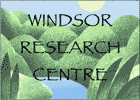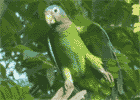| Because of the way birds replace their worn-out feathers (we call this a “moult / molt cycle”), it’s possible to look at a bird and figure out its Stage of Life, in relation to the calendar month. Let’s take a hypothetical songbird, which we’ll call Squit. |
||
| As Squit chips and wriggles its way out of the egg, we learn it's an altricial species, one which requires complete parental care for food and warmth: Squit is almost completely naked, except for a few wispy, downy feathers. | As the days pass, Squit’s parents bring in food and Squit uses this energy supply to grow muscle, bone, brain…everything. The few wispy feathers are replaced with a thick coat of down feathers, which gives Squit good insulation to stay warm, so Mom or Dad don't have to do full-time incubation. | Eventually, "proper" feathers grow – feathers which will be good enough for Squit to sustain flight when it makes its first flight from the nest ("fledges"). |
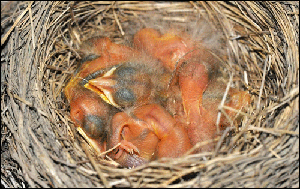 |
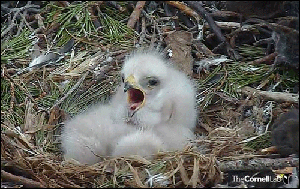 |
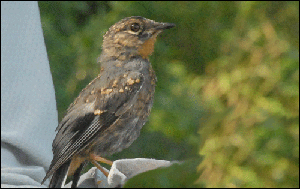 |
| Squit fledges in JUVENAL plumage – all feathers are the same age class. In the majority of birds, the sex of birds in juvenal plumage cannot be determined: males and females look alike. So Squit is still an “it” for our pronoun usage. |
 |
| Remember, Squit had been allocating energy to growth and maturation, so the resultant feathers are good enough for flight and sort of OK for protecting from wind, rain and sun. To put in a different way, the essential feathers on the wings are good but the less-essentials (body) are poor quality. Squit’s body feathers wear quickly and so, within a month or so after fledging, Squit will undergo a Pre-Formative Moult, which when finished puts Squit into its FORMATIVE plumage. This is also called a 1st BASIC plumage. |
 |
| Typically with this moult, which occurs late summer to early fall (autumn) (July – September), all the head and body feathers and some or all of the “secondary coverts” (the covers which protect the upper part of the wing) are replaced. When we look at Squit’s wing, we can see two generations of feathers: FORMATIVE feathers in the secondary coverts and tertials; JUVENAL feathers in the primary coverts and the flight feathers. In the jargon, we say Squit has a “Moult Limit”. In some species where adult males and females have different plumage colours, the male colouration might start to appear in FORMATIVE plumage… but if it doesn’t, we can’t yet conclude that the bird is a female: young males can be "late bloomers" with regards to showing their final colours! | click to enlarge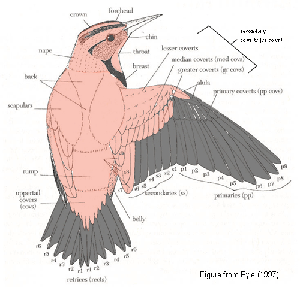 |
| It’s December 31st , Squit is in FORMATIVE plumage and is still a Hatch-Year (HY) bird. As the New Year rings in on January 1st, Squit is still in FORMATIVE plumage, but Squit is now a Second-Year (SY) bird. As far as Squit is concerned, nothing has changed, still need to find food, shelter, etc. |  |
| In the early months of spring (Feb-April), individuals (often the males) in some species will have another partial moult of head and body feathers, so they can look their absolute best for the start of the breeding season. For an SY bird, this would be a 1st Pre-Alternate Moult which results in 1st ALTERNATE plumage. This also is sometimes called 1st BREEDING plumage. If Squit did this, it would still have two (and possibly three) generations of feathers on the wing:
|
 |
| Spring rolls into summer and its time for all Squit's feathers, especially those worn & tatty JUVENAL flight feathers, to be replaced. For Squit, this 100% replacement results in a DEFINITIVE plumage (also called Basic or Adult). For the rest of Squit’s life, every year in late summer-to-early fall, Squit will undergo a complete moult. We won't see any moult-limits in the wing coverts - everything will be nice and uniform. |
 |
| And with this DEFINITIVE plumage, those species which are sexually dimorphic – males and females can be distinguished by the colouration patterns – we can finally say with 100% certainty whether Squit is male or female.
Compare “Squit” as a sexually dimorphic Orangequit to a sexually monomorphic Bananaquit . I’ll let you chose who “Squit” should be ☺ |
|
| From here on, because we don’t see a moult limit, we know Squit was not born in the current year, so the best we can say is that Squit’s age is “After Hatch Year” (AHY) from September – December
and “After Second Year” (ASY) from January through August... Squit could be 3 years old, Squit could be 13 years old, we cannot tell. Unless permanently marked with, say, a leg band, we can’t be sure exactly how many years Squit has lived, but every year in mid-summer-to-early-fall, Squit will replace all feathers, to be sturdy and weather-proofed for another year. |
 |
Of course, if Squit's species has a Pre-Alternate / Breeding Moult in the spring, Squit will show two generations of feathers:
|
 |
Here's an example: |
||
|---|---|---|
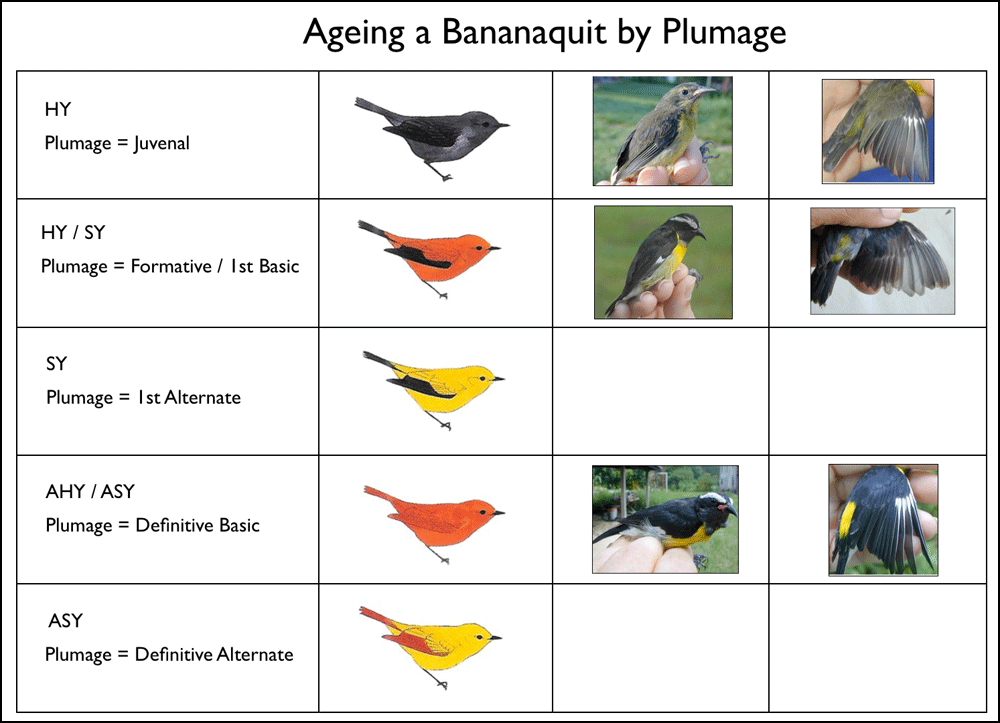 |
For more information about moult cycles (Yes, there is more...):
Howell, S. N. G., C. Corben, P. Pyle, and D. I. Rogers. 2003. The first basic problem: a review of molt and plumage homologies. Condor 105:635-653.
Humphrey, P.S. and K.C. Parkes. 1959. An approach to the study of molts and plumages. Auk 76:1-31.
Hmphrey, P.S. and K.C. Parkes. 1963. Comments on the study of plumage succession. Auk 80:496-503.
Jenni, L. and R. Winkler. 1994. Moult and ageing of European Passerines. Academic Press, London, UK.
Pyle, P. 1997. Identification Guide to North American Birds: Part I. Slate Creek Press, Bolinas, California, USA.
Ryder, T.B., and J.D. Wolfe. 2009. The current state of knowledge on molt and plumage sequences in selected Neotropical bird families: a review. Ornitologia Neotropical 20:1-18.
Wolfe, J.D., E.I. Erik I. Johnson and R. S. Terrill. 2014. Searching for consensus in molt terminology 11 years after Howell et al.'s “first basic problem”. Auk 131: 371-377.
Hawkins, G.L. 2012. The 'first basic problem' revisited: a re-evaluation of Howell et al. (2003). Wilson J. Ornithology: 1 June 2012 via thefreelibrary.com
